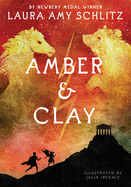
Newbery Medal-winning author Laura Amy Schlitz (Good Masters! Sweet Ladies!) has created a literary feast in this intoxicatingly original tale that takes place in ancient Greece. Amber & Clay is part sweeping saga and part epic narrative, with liberal doses of ancient history, drama, mythology and philosophy included. Painstakingly researched, the 500-plus-page volume follows the odyssey of two 5th-century BCE children destined never to meet--in the living world.
In parallel narratives, Rhaskos, an enslaved Thracian boy living in Greece, and Melisto, a highborn Athenian girl, follow their respective--and severely circumscribed--paths. Rhaskos's mother, also enslaved, is sold when the boy is five, leaving him to the whims of the masters of their home. "I was too small to be much use,/ but I was big enough to pick up turds." Horses--and their manure--become Rhaskos's life. One day, after sneaking inside the house of his master, Rhaskos sees his first-ever painting: "A wonder before my eyes." It is a horse "large enough to ride": "You could see the wind ruffle its mane,/ the sinewy legs pranced, the nostrils flared;/ and it had wings,/ luminous/ spread like the wings of a swan." Rhaskos becomes obsessed with trying to re-create an image as lifelike as this and begins scratching out drawings in the dirt. Later, when he is sold off to a potter, his growing artistic ability becomes useful. At the same time, he develops a second and unusual (for a "thickheaded" "barbarian," that is) passion for philosophy when he befriends a funny "old man/ who had no beauty to display" named Sokrates.
Melisto is the spitfire daughter of an important man; she is spoiled by her father and near despised by her mother. The person Melisto loves most, besides her father, is Thratta, the enslaved woman who takes cares of her. (Thratta also happens to be Rhaskos's mother, purchased at a slave auction in Athens.) As the daughter of a distinguished man, Melisto is chosen along with other pre-pubescent girls to leave her home to be a "bear-servant" to the goddess Artemis. In this brief, final season of freedom before returning home to marriage and the duties of the ruling class, the girls live as Bears: they dance, run and sacrifice goats to honor Artemis, who will later help them with childbirth. Unfortunately, Melisto is destined never to emerge from this hiatus; she dies during the preparation for a ritual sacrifice.
Although readers don't get to spend much time with Thratta before she disappears into her own fate, this grieving mother becomes the link between the two children. Mourning the loss of Melisto and desperate to end her son's enslavement, she casts a binding spell between them. This "blessed curse" demands Melisto free Rhaskos or risk never resting in death, setting her on a long and twisted path.
Depending on the point of view--there are many in Amber & Clay--and what the scene calls for, Schlitz uses a variety of literary forms. Rhaskos usually narrates in first-person verse, except in a few pivotal moments. Melisto's form is third-person prose until the children find each other, at which point she enters his verse world and he, briefly, turns to prose. When the two come together and work to fulfill Thratta's spell, the interlude is choreographic in nature. Melisto's ghost feels vibrantly alive in these scenes, bantering with Rhaskos in a pas de deux that reveals just how seldom the two have ever been able to have genuine, childlike friendships: "She'd ask a question, and I'd answer it--/ and when I ran out of breath--/ because the path was steep--/ she'd talk, telling me about her life." In verse, Melisto, who was once called "heavy" and "dark" by Thratta, is light and quick ("She ran with her fingers outstretched,/ growling like a wild beast, giggling") and Rhaskos is thrilled to be allowed to speak at all: "I don't talk either./ If you're a slave, no one listens."
Known for her spectacular world-building skills in books like The Night Fairy, The Hired Girl and her Newbery Honor book Splendors and Glooms, Schlitz delves deep into the world of Ancient Greece. She doesn't neglect Mount Olympus, either, because the gods' lives are thoroughly entwined with those of mortals. Periodically, Hermes, Artemis or Hephaistos chimes in, commenting in verse on the action of the humans with varying degrees of pity, snark and empathy. Hermes, especially, can be a card: "Allow me to kick off the winged sandals,/ wiggle my toes,/ and put my feet up. It's Dullsville in Athens."
Archeological "exhibits" and museum-style descriptions, realistically illustrated in mixed media by Julia Iredale (Myths and Legends of the World), are interspersed throughout the book. These pottery fragments and figurines inform the course of each chapter. For example, a shard from a small pot depicts girls dancing around an altar decorated with scrolls, presumably while serving Artemis as "Little Bears," a mysterious practice that Schmidt elucidates and elaborates on in the chapters that follow. (In the author's notes Schmidt describes the lengths she went to in order to learn as much as she could about cult practices like these.)
Melisto, "electric as amber," and Rhaskos, "indestructible as clay," are as surprising a pairing as any in literature, ancient or modern, and their story is both epic in nature and scrupulous in detail. Amber & Clay is a true marvel. --Emilie Coulter

